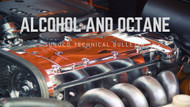Alcohol and Octane
By on Oct 08 2018
Alcohols like methyl alcohol (methanol) and ethyl alcohol (ethanol) are often used in race fuels. Sometimes they are a small part of the fuel and sometimes they are a primary component of the fuel. Methanol is commonly used “straight” – that’s why it’s called racing alcohol by many. Ethanol can also be used straight, and some racers do, but it’s more common to hear about E85, a blend of about 85% ethanol.
Much has been said about the octane rating of alcohols. However, technically speaking, the octane ratings of alcohols can not be measured.
All octane test engines, as defined in the octane rating procedures set forth by the American Society for Testing and Materials (ASTM), are carbureted. Air/fuel ratio adjustments on octane engine carburetors are limited and can not accommodate the extremely different air/fuel ratio requirements of pure alcohols.
Blends of alcohols can be tested to determine what is called a “Blending Octane Value” or BOV. Basically, the octane rating of an alcohol/gasoline blend is compared to the octane rating of the gasoline without alcohol and some math is done to calculate what the effect of the alcohol was on the octane of the gasoline. Thus, a BOV is determined. However, a BOV is not the same thing as a normal octane rating.
Octane numbers at the pump are determined by taking the average of two ASTM-specified octane tests – the Research Octane Number test (RON, or simply “R”) and the Motor Octane Number test (MON, or simply “M”). The average is expressed as (R+M)/2 and is sometimes referred to as the Antiknock Index or AKI. In the United States, pump gas is sold based on AKI and it is this value that we typically use to represent a fuel’s octane rating. The square yellow octane stickers you see on gasoline dispensers indicate the (R+M)/2 octane rating.
BOVs for methanol and ethanol typically overstate octane. This is because the law of diminishing returns applies. While a little alcohol can bump octane by a few numbers, twice as much alcohol does not result in twice as much octane increase. So while it may look like an alcohol has a high octane number when a small amount is used (as in determining a BOV), its real octane value is not as high. Problem is, the real number can’t be determined… so we’re left to guessing.
Ethanol is a good example. Its BOV is generally stated as 112 octane or so. Again, this implies that if you mix a little ethanol into gasoline, some math tells us the octane will increase as if the ethanol were 112 octane. In fact it’s not… it just seems that way when a small amount is added.
Best estimates of the actual octane rating of pure ethanol place it at about 100 octane. This is probably a conservative value but it is one we are comfortable with. If you see octane claims for ethanol in the 112 range, be suspicious that the octane number might be incorrectly based on BOV.






